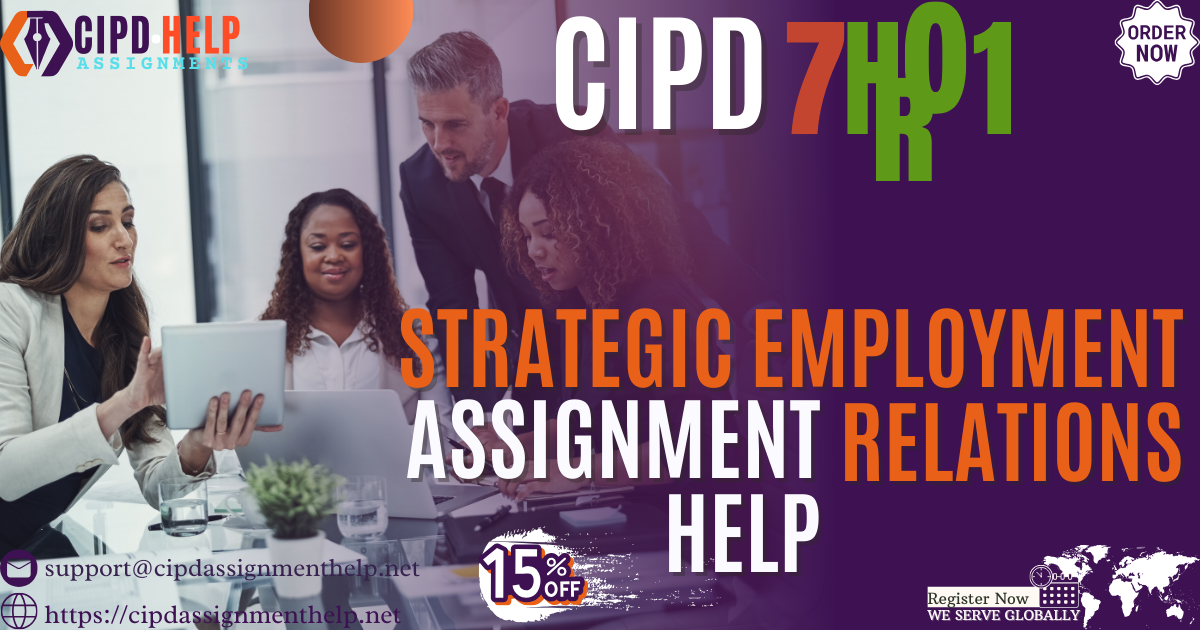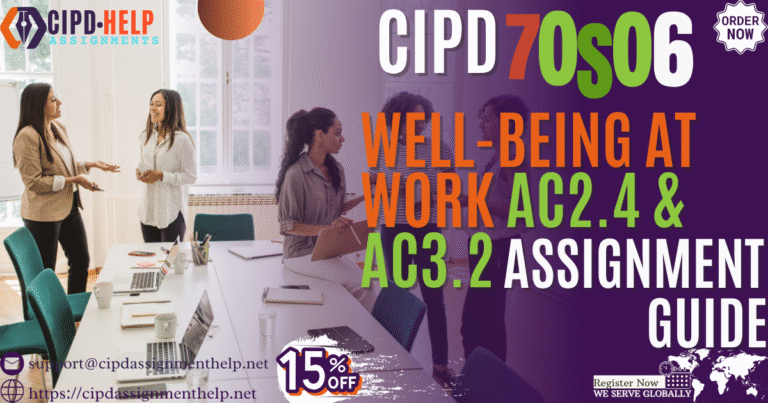7HR01 Strategic employment relations Student Assessment Brief
The 7HR01 Strategic Employment Relations Student Assessment Brief offers a detailed look at employment relations within an organisational setting, helping students engage with current debates and workplace realities. This brief is part of the CIPD Level 7 Advanced Diploma and focuses on the shifting dynamics between employers, employees, and representative bodies. If you’re working through this unit, you’ll know how theory doesn’t always match practice, and that’s what makes it interesting. From employment law tensions to collective bargaining strategies, the assessment challenges you to think critically. We’ve pulled together key information, plus common questions students often ask when tackling this assignment.
Assessment questions
At a recent team meeting some of your junior people professional colleagues openly shared their frustrations about their understanding of employment relations. One individual claimed, ‘I continue to read different views on employment relations but do not really understand some of the key concepts or why we do what we do.’ To help support their continuing professional development your manager has asked you to write a briefing paper that responds to the following questions.
For the purpose of this assessment, you need to apply your answers to either your own organisation or one with which you are familiar.
It is essential that your reading of the published literature is used to inform your responses to all questions.
Understanding Employment Relations Perspectives
Question 1 (AC 1.1): Provide an overview of the three main perspectives on employment relations, unitarist, pluralist and radical, explaining which approach is adopted at your organisation, critically evaluating how this influences the work of its people professionals.
There’s something almost reassuring about hearing someone in the room say what others are quietly thinking. That’s what happened during a recent team meeting when a junior colleague admitted, somewhat hesitantly, “I keep reading about different views on employment relations, but I still don’t understand what they really mean or why it even matters.” There was a pause. Then a few nods. And just like that, we were all having a much-needed conversation.
So this briefing is for those of us still puzzling over what these perspectives are really about, and how they show up in our day-to-day working lives.
Let’s start with the three common ways people look at employment relations: unitarist, pluralist, and radical. They’re not just theoretical ideas; they shape how organisations approach things like conflict, decision-making, and employee voice.
Unitarist perspective is probably the most common in workplaces like ours, where management and employees are viewed as being, ideally, on the same team. In this view, any disagreement is seen as a result of poor communication or a few bad apples, rather than a sign of deep-rooted issues. From what I’ve seen at our place, this view seems to dominate. Managers often expect loyalty and cohesion, and conflict is quietly discouraged. When concerns do surface, they’re usually addressed privately rather than through formal structures.
Then there’s the pluralist view. This one accepts that people in an organisation have different interests, and that these will sometimes clash. So trade unions and collective bargaining aren’t seen as threats, but more like legitimate parts of the system. I’ve only seen bits of this here. A few departments work more closely with union reps, and HR has to wear more than one hat, balancing organisational goals with what employees are asking for. It’s messier, but also maybe a bit more honest?
Lastly, we have the radical perspective. This one takes a much more critical stance. It sees conflict not just as a bump in the road but as something rooted in power imbalances. According to this view, employment relations are shaped by economic structures. with employers usually holding more of the cards. It’s not something we talk about openly in our organisation, but I’ve noticed that when people raise questions about pay transparency or inequality, they often get brushed off, which could suggest an undercurrent of this tension.
Now, how does this all shape the work of our people professionals? Well, quite a lot. When we lean heavily into the unitarist view, HR tends to focus on keeping everyone ‘on board’. There’s a big emphasis on performance, morale, and internal branding. But this can mean that real concerns get softened or even ignored. It can leave people feeling like they’re being listened to but not truly heard.
On the other hand, if we took the pluralist view more seriously, perhaps we’d have stronger formal mechanisms for dialogue, not just surveys, but real negotiations. People professionals would then need different skills: managing disagreements, recognising multiple perspectives, and living with a bit of friction.
To be honest, there’s no perfect model. Organisations aren’t always consistent, and the lines between these views blur. Some days it feels like we’re all in it together; other days, not quite.
And maybe that’s the point, to stay aware that these perspectives aren’t fixed rules, but ways of looking at the same picture from different angles.
Employment Relations in the Context of Labour Market Pressures and Organisational Direction
Question 2 (AC 2.2): Employment relations strategies are shaped by competitive pressures; review how the current labour market and organisational strategy impacts the management of employment relations within the organisation.
In recent months, it’s become increasingly clear that how we manage employment relations isn’t shaped in isolation. It’s tied, directly or indirectly, to what’s happening around us. In the case of our organisation, which operates in the private healthcare sector in Nairobi, both the local labour market and our organisational strategy have played a noticeable role in how we handle employment matters.
Let’s start with the labour market itself. It’s been tighter than expected. We’ve seen a surge in demand for experienced nursing staff, especially those with specialist training. At the same time, there’s been a notable outflow of professionals seeking better pay abroad. That puts pressure on recruitment, yes, but also on retention. It becomes less about filling roles quickly and more about keeping the people we have. There’s also something else, new entrants into the field aren’t always coming with the depth of training we’d prefer. So the quality gap adds another layer of difficulty.
Now, because of these market changes, our approach to managing people has had to adjust. There’s more sensitivity to pay expectations, of course, but also to work-life balance and how shift patterns are managed. We’re seeing that what used to pass as acceptable scheduling a few years ago is now a point of contention. Even casual comments in meetings hint at a growing sense of fatigue. Whether that’s because of workload, the general job climate, or something in between is hard to pinpoint, but it’s there.
From a strategic angle, the organisation’s goal of expanding outpatient services has forced another set of changes. With more outpatient facilities comes more staffing requirements, admin, clinical, and support roles. And because the rollout is happening relatively quickly, there’s been a sense of urgency in HR planning. Some decisions feel rushed. One week we’re asked to scale up training; the next, we’re tweaking job descriptions to make roles broader. It’s a bit of a balancing act, and not always a graceful one.
This shift has also meant rethinking how grievances and consultations are handled. In theory, structures are in place, surveys, team feedback forums, but in practice, the pace of strategic growth sometimes eclipses those mechanisms. It’s not intentional, but when managers are pressed for time, formal processes don’t always get prioritised. That creates tension. Not everywhere, but enough that it comes up in team conversations.
There’s no single answer for how best to manage employment relations under these pressures. And frankly, not every step we’ve taken has landed well. But it’s the reality of working within a competitive environment. What we’ve found, through trial and error, mostly, is that consistency in communication helps, even if the answers aren’t perfect.
So if junior colleagues feel unclear about why we approach employment matters a certain way, it’s understandable. Because sometimes, even those making the decisions aren’t completely sure they’ve got it right. But we try, adjust, listen, and try again. And maybe that’s where most of our efforts now sit.
Strategies to Improve Employee Engagement and Performance
Question 3 (AC 3.4): Propose two distinct strategies to improve levels of engagement within the organisation and evaluate how their impact on organisational performance can be measured. Justify your recommendations.
We’ve had some rather honest conversations lately, particularly in the last team meeting, and one thing stood out, there’s still a gap in how some of us make sense of employment relations. One colleague even said they keep coming across different opinions but struggle to understand the point of it all. It’s a fair concern, and actually, quite common. So, I want to focus on two strategies we could realistically try in our organisation to improve how engaged people feel at work. Not in theory, but in ways that might actually translate into something more noticeable on the ground, and ultimately, in how we perform as a company.
1. Giving people a say in what matters to them
There’s something underrated about feeling heard. Not just being asked for feedback once a year, but being invited to shape things that directly affect you, shift patterns, workload distribution, or even team rituals. At our organisation, there’s still a sense that decisions are passed down rather than built together. That’s part of the reason morale dips during periods of change, because people don’t feel part of the process.
One possible approach could be establishing small cross-department working groups on issues staff often grumble about, like scheduling or communication breakdowns. These wouldn’t be top-down committees, but small teams with some autonomy to test ideas. You probably wouldn’t need a huge budget, just leadership willing to listen and not override everything.
Now, how would we know if it’s working? Staff surveys help, yes, but perhaps too generic. We could track things like uptake of voluntary initiatives, reduction in minor grievances, or even just whether people opt into these groups in the first place. Sometimes the best measure of engagement is whether people bother to show up when they don’t have to.
2. Career development that doesn’t feel performative
A lot of us say we want development, but that doesn’t always mean we want more training courses. Sometimes what people really crave is knowing there’s a future for them here, something to work towards. Right now, it still feels like progression is vague, or tied to roles that rarely open up. That can make people disengage silently, even if they don’t leave.
Instead of one-size-fits-all development plans, managers could have more regular, informal career chats, perhaps quarterly, where people get to talk about what’s next for them. It wouldn’t be formal reviews or competency matrices, just… conversations. Small goals, nudges, maybe a shadowing opportunity or mentoring link-up.
We could keep an eye on how many internal moves take place, how many people ask for development support after these chats, or even how retention changes in teams where managers consistently hold them. It’s not just about measuring skill growth, but whether people stay, and stay interested.
Neither of these strategies requires reinventing how we work. In fact, the best ideas often feel quite ordinary. But the real shift is in whether people feel seen, heard, and trusted. That’s where engagement lives, not in grand schemes, but in small, consistent signals that they matter.
Collective Bargaining in Unionised and Non-Unionised Settings
Question 4 (AC 4.1): Identify two different forms of collective bargaining, one in a unionised and one in a non-unionised environment, critically analysing their role in determining pay and resolving differences. Explain to what extent either applies to your own organisation.
This briefing looks at two contrasting approaches to collective bargaining, one through a trade union and one without, and how these play out in real organisational settings. I’ve used our own workplace as a reference point where needed, though the thinking could apply more widely.
Let’s start with the unionised setting. One of the most recognised methods here is single-employer bargaining. This happens when a union and a specific employer meet to negotiate over pay, working hours, and sometimes other employment conditions. It’s usually quite structured. There are formal steps, sometimes tense pauses, a lot of back-and-forth. But crucially, the union represents many employees, so there’s a collective strength behind their position. For example, in public healthcare settings, like where I previously worked, the union, often the National Union of Nurses, sits down with hospital management to discuss salary scales. These talks can get stuck over affordability or working conditions, but they offer a shared space to air grievances and, ideally, reach agreements that feel fair to most.
That said, this kind of bargaining isn’t always smooth. Sometimes you get gridlock. One side might feel unheard, the other stretched. I remember a colleague saying once that even though we had “a seat at the table,” the process often felt like it moved in slow motion. Progress, yes, but sometimes just barely.
Now, compare this with direct bargaining in a non-unionised context. In our current organisation, this is the norm. Employees speak directly to line managers or HR about their pay or any issues. On paper, this seems straightforward. No need for representation, no group dynamics. But it can feel, well, a bit exposed. Some employees are confident enough to ask for a raise or question pay decisions. Others aren’t. And that makes the outcomes uneven. It’s a quieter process, perhaps even more fragmented.
One case comes to mind, a colleague who asked for a salary review after taking on extra duties. The manager agreed in principle but the adjustment took months and wasn’t clearly communicated. There was no structured follow-up, no formal record of the negotiation. It left them feeling unsure. Maybe that’s the thing with direct bargaining, it can work well, but it depends heavily on the personalities involved, and there’s often little consistency.
So, which works better? That’s hard to say. The union model brings shared power and structure, but it can be slow or overly formal. Direct bargaining gives individual control but lacks safeguards. In our organisation, the latter applies, but I sometimes wonder if a hybrid model, where employee groups could consult internally before approaching management, might strike a better balance. Not perfect, but perhaps more supportive for those who aren’t comfortable pushing their own case alone.
FAQs on 7HR01 Strategic Employment Relations Student Assessment Brief
1. What is the main purpose of the 7HR01 assessment brief?
It encourages students to examine how employment relations are shaped by both organisational decisions and wider socio-political forces. You’re expected to critique existing approaches and suggest alternatives.
2. Do I need to use real workplace examples in my assessment?
Yes, though you can use hypothetical ones if needed. Still, real examples—drawn from your workplace or a known organisation, often give your work more depth and realism.
3. How academic is the writing expected to be?
It’s formal, but not overly rigid. There’s room for thoughtful reflection and critique. You’re not just regurgitating theory, you’re applying it in context and offering a perspective.
4. Is employment law a central part of the brief?
It plays a part, but it’s not the only focus. Law intersects with employee voice, negotiation, power dynamics, and broader employment relations systems.
5. What trips students up most often in this unit?
Rushing the critical analysis. Many outline the ‘what’ but forget the ‘why it matters’ part. Another one? Not linking different strands of employment relations back to strategy. This is what CIPD 7 is all about!





